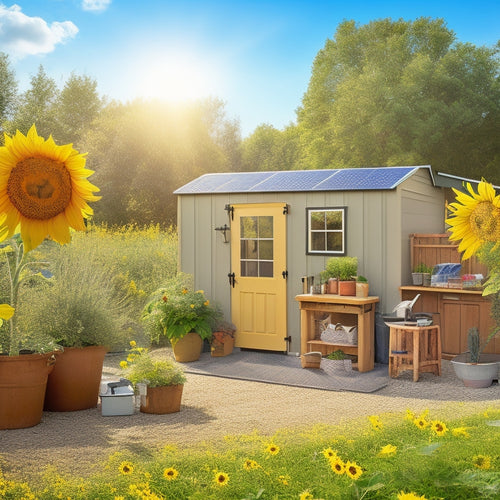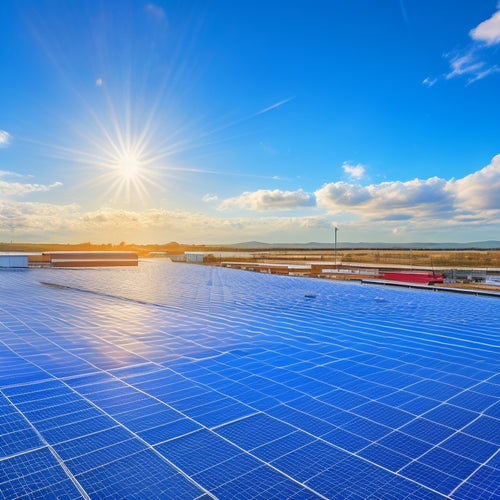
Top DIY Tips for Efficient Home Energy
Share
As you tackle your DIY solar installation, prioritize high-efficiency solar panels with conversion rates over 26%, and consider grid-tie, off-grid, or hybrid kits depending on your home's connection. When installing, don't compromise on safety - wear protective gear, turn off the main power supply, and hire a licensed electrician if needed. Optimize panel angles, clean them regularly, and minimize shading to maximize energy capture. Monitor your solar output to identify areas for improvement and make informed decisions. By following these DIY tips, you'll be well on your way to utilizing efficient home energy - and optimizing your system for maximum savings and performance is just the beginning.
Overview
- Optimize solar panel angle for maximum sunlight capture to increase energy harvesting.
- Regularly clean solar panels to prevent dirt buildup and energy loss.
- Choose high-efficiency solar panels and reliable inverters for a successful DIY installation.
- Ensure proper installation by wearing personal protective equipment and turning off the main power supply.
- Monitor solar output in real-time to identify areas for improvement and maximize energy potential.
Solar Panel Efficiency Ratings
When considering solar panels for your home, maximizing energy production is vital, and understanding solar panel efficiency ratings is fundamental to achieving this goal.
High-efficiency silicon solar cells, for instance, can achieve conversion rates over 26% high-efficiency solar cells, making them suitable for off-grid systems.
You'll want to know that solar panel types vary in efficiency, with monocrystalline silicon panels boasting the highest ratings, typically between 15% to 20%.
Polycrystalline silicon panels follow, with efficiencies ranging from 12% to 15%.
Thin-film panels, on the other hand, have lower efficiencies, usually between 7% and 14%.
When making an efficiency comparison, consider the panel's wattage output per hour of peak sunlight.
Higher efficiency ratings don't always mean higher costs, so it's vital to weigh your options carefully.
Choosing the Right Solar Kit
You've optimized your solar panel selection by understanding efficiency ratings. Now it's time to choose the right solar kit for your home energy needs.
When selecting a solar kit, consider the type that suits your requirements. Grid-tie kits are ideal for homes connected to the grid, while off-grid kits are perfect for remote areas. Hybrid kits offer a combination of both.
Consider the installation costs, which vary depending on the kit type and complexity. On average, installation costs range from $2.50 to $3.50 per watt.
Many solar kits, such as those from WindyNation and Renogy, offer pre-wired and pre-assembled components to simplify installation high-efficiency solar panels.
Make sure you choose a kit that meets your energy demands and budget. By doing so, you'll be well on your way to utilizing the power of solar energy and reducing your reliance on the grid.
DIY Installation Safety Tips
Safety should be your top priority when installing your solar kit. You're taking on a complex project, and it's vital to protect yourself from potential hazards.
Wear personal protective equipment, such as gloves, safety glasses, and a hard hat, to prevent injuries from falling objects or electrical shock. Make certain you're familiar with tool usage, and use the right tools for the job to avoid accidents.
Always turn off the main power supply before starting work, and consider hiring a licensed electrician if you're unsure about any aspect of the installation.
High-efficiency panels and reliable inverters are fundamental for a successful DIY installation, so be certain to choose them wisely.
Maximizing Energy Harvesting
Five key factors influence the amount of energy your solar kit harvests: panel angle, panel cleaning, shading, temperature, and inverter efficiency.
You'll want to optimize each of these factors to maximize your energy yield. Verify your panels are angled correctly to capture the most sunlight, and clean them regularly to prevent energy-sapping dirt buildup.
Minimize shading from trees or nearby structures, and consider using a tracking system to adjust your panels' angle throughout the day.
Inverters with high efficiency ratings will also help you get the most out of your system.
Monitoring Your Solar Output
During peak sun hours, your solar kit is generating electricity, but are you keeping tabs on its performance?
Monitoring your solar output is essential to guarantee you're utilizing the maximum energy potential from your system. By tracking your energy production, you can identify areas for improvement, optimize your system's performance, and make adjustments to maximize your energy independence.
Invest in a solar output monitoring system that provides real-time data on your energy production. This will enable you to track your daily, weekly, and monthly energy output, and make informed decisions to optimize your system's performance.
With accurate solar output monitoring, you'll be able to enjoy the freedom of relying on renewable energy and reducing your reliance on the grid.
Frequently Asked Questions
Can I Install Solar Panels on a Metal or Clay Tile Roof?
You can install solar panels on a metal or clay tile roof, but it's essential to guarantee compatibility; metal roofs require specialized mounts, while clay tiles may need additional structural support to handle the added weight of solar panel installation.
How Long Does It Take to See a Return on My Investment?
Coincidentally, you're wondering how long it takes to see a return on your investment, just as you're about to reap the benefits of energy savings! Typically, you'll break even in 5-7 years, but with rising energy costs, you might see a return sooner, depending on your investment timelines.
Do Solar Panels Work During a Power Outage?
You're wondering if solar panels work during a power outage - the answer is, they don't, unless you have a solar battery, which provides grid independence and emergency power, ensuring your energy efficiency and freedom from utility reliance.
Can I Add More Panels to My Existing Solar System?
You're wondering if you can enhance your solar setup - great question! Yes, you can expand your solar panel array, but first, verify system compatibility and assess your existing infrastructure to secure a seamless solar panel expansion.
Are There Any Rebates or Incentives for DIY Installations?
You'll find rebates and incentives for DIY installations, but first, you'll need to conduct energy audits to qualify; then, you can offset installation costs with tax credits, state-specific grants, and utility company rebates, enhancing your energy independence.
Ready to Buy
As you flip the switch, utilizing the power of the sun to energize your home, you're left wondering: what's next? Will your DIY solar project pay off? The answer lies in the data. Keep a close eye on your monitoring system, and get ready to uncover the secrets of your energy output. The numbers will reveal the truth - are you reaping the rewards of your hard work, or is there room for improvement? The expedition to energy efficiency has just begun, and the results are about to get electrifying.
Related Posts
-

How to Achieve a Zero-Waste Lifestyle for a Greener Tomorrow
To achieve a zero-waste lifestyle, start by adopting the principles of refusing, reducing, reusing, and recycling. Sw...
-

Building an Emergency Backup Solar Power System in 5 Essential Steps
Building an emergency backup solar power system involves five key steps. First, assess your daily energy needs to ide...
-

Commercial Solar Energy
As you consider powering your business with commercial solar energy, you'll uncover it offers a triple benefit: signi...


